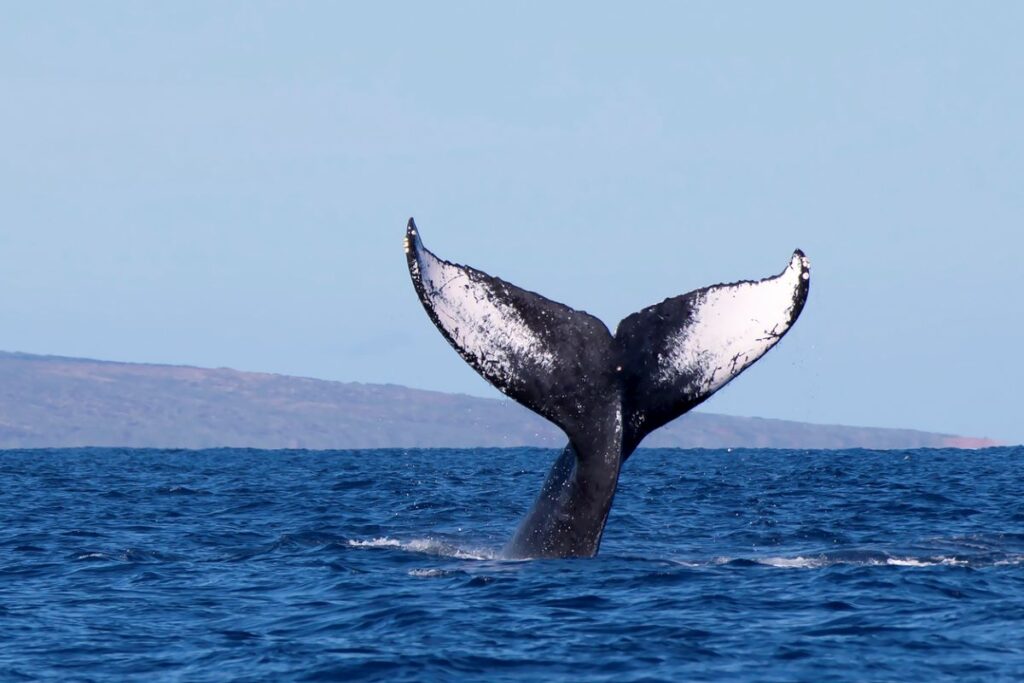Winter to spring is whale watching season in Hawaiʻi. The North Pacific humpback is the most common whale found in Hawaiʻi. Thousands of humpback whales migrate every year, swimming 3,000 miles from Alaska to Hawaiʻi and back again. While many boat tours get you on the water for whale watching, humpback whales are easy to spot from Hawai’i shores during migration season.
Peak humpback whale watching season in Hawaiʻi is January to March. However, the first and last whales of the season can be spotted from mid-November to early April. Eventually, humpbacks head back to Alaska, a journey that takes four to six weeks.
While in Hawaiʻi, humpbacks give birth, nurse newborn calves, and mate. The adult whales don’t feed here because they are busy caring for their offspring. From June to October the humpbacks are back in Alaska chowing down on their favorite krill.
There are over a dozen species of whales (and dolphins) plying Hawaiian waters year-round, including sperm whales and pilot whales. However, most of these are rarely seen because they swim in very deep waters, most typically off Hawaii’s Kona Coast or Oahu’s western shores.
Whale watching tips
Whale watching takes some patience. You increase your chances of seeing whales if you spend 1-2 hours scanning offshore. If the sea is choppy, it can be difficult to spot whales among the wave crests.
You might first see a big spout of water erupting from the ocean surface as a whale exhales. Look ahead in the whale’s direction of travel. Eventually you may see the whale’s back curve out of the water and then their tail has they dive.
Whales are most active in the morning (before noon) or late afternoon (Hawaiian sunset is 6:00-6:30PM in winter). At these times, you may see a whale breach, jumping halfway or more out of the water. Or catch them slapping their tail flukes or pectoral fins against the surface of the ocean.
Many companies offer whale watching tours in season. There is a wide variety of tours on small and large vessels, from zodiacs to catamarans. Some are family-friendly trips, some are culturally inclined, and others have a party boat atmosphere. Search the Web or Yelp for current options and recommended tours from your location.
Since we focus on free and cheap things to do across the Hawaiʻi Pae ʻĀina, listed below for each island are the best places to watch whales for free from beaches and other outlooks. We also include some institutions with whale exhibits and educational information. Some require an admission fee that is far less expensive than a guided boat tour and can greatly enhance your shore excursion.
What to bring for whale watching
- Dress for the weather (rain, wind, sun). Light layers are recommended to subtract or add as needed.
- Sun protection (reef-safe sunscreen lotion, hats, SPF-enchanced clothing, umbrella, popup tent).
- Beach chairs or a blanket to sit on.
- Cooler with water and snacks.
- Binoculars, spotting scope, smartphone, or DSLR camera with telephoto lens (70-200mm or up to 500mm).
Tips for photographing whales
- Charge your camera battery and/or bring an extra battery.
- Bring extra memory cards if you plan to shoot a lot of images.
- Set your camera on sports or action setting or manually set a fast shutter speed (1/500 to 1/1000) and ISO 400 or higher if sunny, or auto ISO if cloudy.
- Set your camera on continuous shooting if possible—but be sure you have plenty of battery power and memory cards!
- Optional: tripod and shutter release so you can watch the ocean constantly while being ready in the moment to shoot whale action.

Whale watching takes patience. You might first see only a big spout of water erupting from the ocean surface as a whale exhales. In the photo above, a humpback whale is spouting near Lahaina Maui. Photo by davidhoffmannphotography via iStockphotos by Getty Images.
Whale watching from land on Hawaiʻi Island
Prime whale watching locations on the Big Island are in the morning along the northwestern coast from North Kona to Kohala. Listed below are some accessible whale-watching locations (listed north to south).
- Hawaii Camping Reservation – Kapa`a Beach Park
- Lapakahi State Historical Park
- Puʻukoholā Heiau National Historic Site
Whale watching from land on Kauaʻi
Listed below are some accessible whale watching locations on Kauaʻi (clockwise from the north).
- Hanalei Bay Beach in the north
- Kilauea Point Lighthouse & National Wildlife Refuge (kauairefuges.org) in the north
- Kealia Beach | Kauai.com on the eastern side
- Ke Ala Hele Makalae | TrailLink on the eastern side
- Maha’ulepu Heritage Trail: Shipwreck Beach to Punahoa Point | AllTrails in the southeast
- Poipu Beach on south shore
Whale visitor center on Kauaʻi
- Visitor Center in Līhuʻe for the Hawaiian Islands Humpback Whale National Marine Sanctuary features exhibits, displays, and a variety of family activities. Hours: Wednesday and Friday: 2:00 p.m. – 5:00 p.m. Saturday and Sunday: 11:00 a.m. – 2:00 p.m. Address: Kukui Grove Center, 3-2600 Kaumualii Hwy, Līhu‘e, HI 96766.
Whale watching from land on Lanaʻi
Whale watching from land on Maui
Maui Island is one of the best places in the world to see whales. The area between Maui, Kahoolawe, Lanai, and Molokai is a relatively shallow, sandy reef that provides perfect areas for humpback cows (female whales) to give birth and tend to their newborns. Listed below are a some accessible whale watching locations (listed north to south).
- D.T. Fleming Beach Park in the northern part of West Maui
- Kaanapali Beach (Google Map)
- McGregor Point & Lighthouse (Google Map) about 9 miles south of Kahului at Maʻalaea Harbor. The McGregor Point Lighthouse is owned by the Coast Guard and the grounds are open to the public (the lighthouse is closed).
- Kama’ole Beach Park in the south at Kihei
- Puu Olai Cinder Cone Trail | AllTrails trailhead begins at Big Beach and the short but steep hike overlooks Makena Beach
- Mākena State Park Oneloa (aka Big) Beach farthest south in Wailea
Whale education & visitor centers on Maui
- Maui Ocean Center Aquarium 3D Sphere experience connects you with Maui’s humpback whales by integrating 4k imagery, 3D active glasses, and a 7.1 surround sound system. Discover the dynamic life, journeys, and social bonds of these intelligent and spiritual creatures under the sea in the first-of-its-kind 3D Sphere, only at Maui Ocean Center. The Sphere is open every day with showings running every half hour. No reservations are required. Not suitable for children age 3 and under. Admission: $39.95. Discounted for seniors (65+) , military, keiki (4-12), and kamaʻāina. Free for annual members, $125/adult, $75/kamaʻāina. Address: 192 Maalaea Rd, Wailuku, HI 96793.
- Pacific Whale Foundation is a nonprofit organization dedicated to saving the world’s whales from extinction PWF offers fee-based programs and services through PacWhale Eco-Adventures to help support its nonprofit work. Address: 300 Maʻalaea Road, Wailuku, HI 96793.
- Humpback Whale National Marine Sanctuary Visitor Center. The view from the scenic beachfront on the south shore of Maui sweeps across the waters of the sanctuary from West Maui and beyond to the islands of Lānaʻi and Kahoʻolawe. The visitor center features exhibits, interactive displays, and weekly programs for the whole family. Hours: Monday-Friday, 9:30 a.m. – 2:30 p.m. Address: 726 South Kīhei Road, Kīhei, HI 96753.
Whale watching from the shore on Molokaʻi
- Hale O Lono Harbor a man-made harbor on the south west coast
Whale watching from on Oʻahu
We’ve chosen less popular beaches that are accessible and usually serene for whale watching. Listed clockwise beginning at Kaʻena Point in the northwestern corner of Oʻahu.
North Shore Oʻahu beaches for whale watching
(Listed West to East)
- Ka‘ena Point State Park in the remote northwestern corner of Oʻahu. Access from either north shore or west Oʻahu. Check Ka‘ena Point page on the State Parks website for updates before heading out.
- Pūpūke Beach Park (includes Sharks cove and Three Tables)
- Waiale’e Beach Park (not to be confused with Waialee Beach Park on the south shore)
- Kawela Bay Beach Park (west of Turtle Bay)
- Lāʻie Point State Wayside (near Polynesian Cultural Center)
(Listed East to West)
South Shore Oʻahu beaches for whale watching
- Makapuʻu Point Lighthouse Trail
- Halona Blowhole (Google Map)
- Lānaʻi Lookout (Google Map)
- Spitting Caves and China Walls (Google Maps)
- Diamond Head Scenic Lookout (Google Map) below the crater on diamond Head Road overlooking the ocean
- Magic Island at Ala Moana Regional Park
West Oʻahu beaches for whale watching
- Ka‘ena Point State Park in the remote northwestern corner of Oʻahu. Access from either west Oʻahu or North Shore. Check Ka‘ena Point page on the State Parks website for updates before heading out.
- ʻEwa Beach Community Park (Google Map)
- Koʻolina Beach Park (Google Map)
- Makaha Beach Park (Google Map)

Humpback tail photo by Erin Donalson via iStockphotos by Getty Images
Event calendar of free and affordable things to do
Listed below are all types of free and affordable things to do in the next 30 days across the Hawaiʻi Pae ʻĀina.
Featured Events are listed first each day, highlighted by a photo. These are unique, popular, or annual events that we or our advertisers don’t want you to overlook.
You might also like: Hawaiʻi on the Cheap – affordable living and things to do (hawaiionthecheap.com)
multiple locations
